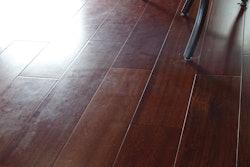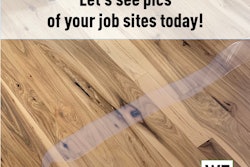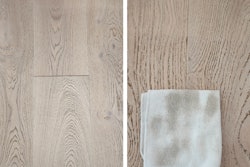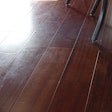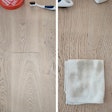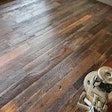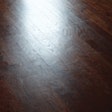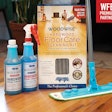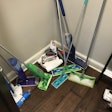Medallion Rx
Can I repair/replace a curled piece of my installed medallion?
Brenda Kubasta, owner and president of Winneconne, Wis.-based Oshkosh Designs, answers:
Before any repair of the inlay is done, it is extremely important that you determine what caused the piece to curl in the first place. Most commonly, it is a lack of sufficient moisture levels in the home. It is vital that reasonable humidity conditions (35-45% RH at 60-75°F) are maintained consistently throughout the home.
Begin by testing and recording levels throughout the home. After confirming that the levels are inadequate, recommend the placement of a humidifier in the room to stabilize the levels before beginning any repair. Surprisingly, this may quickly remedy the problem with minimal additional work from you. As the piece rebounds, it may flatten, and by simply squeezing a small amount of liquid epoxy under the piece and pressing the piece back into place, your repair may be complete.
If it is determined that humidity is not the problem, another cause may be glue-bond failure. This creates a bit more of a repair challenge. Start by contacting the manufacturer of the inlay to discuss your options. The inlay manufacturer will provide you with recommendations and their product assembly process. Most often a replacement piece will be provided and you will receive detailed step-by-step instructions on the removal and replacement of the piece.
Just as with hardwood flooring, inlays will expand and contract during heating and non-heating seasons as well as react to the movement in the flooring surrounding them. It is imperative to stress maintaining the proper humidity levels in the home to avoid unnecessary repairs.
Slow-Dry Sealer
I recently put down a quick-dry oil-based sealer on a red oak floor in a house still under construction. The house was closed in but the HVAC was not hooked up yet. The sealer took two days to dry instead of two hours, like it said on the back of the container. Why?
Mark Mukosiej, technical support & training at Greenwood Village, Colo.-based Arboritec USA, answers:
There are a lot of variables that need to be factored in to have a wood floor job come out successfully. Unfortunately, often the NWFA's and, more importantly, the finish manufacturer's, guidelines for temperature, MC and RH are ignored. When I started out as a floor contractor years ago, I quickly realized that I also needed to be a weatherman. Mother Nature can, and usually does, wreak havoc with a wood floor job. Rarely do we have ideal conditions on a job site. Keeping up with the weather should be a daily habit of every floor contractor.
Temperature, RH and MC of the wood are the key factors that need to be addressed when putting finish down. Most manufacturers' guidelines (on every container) suggest that the RH should be between 35-55%, and the temperature between 60-80°F. The MC of the wood will vary according to the wood species and the region of the country. If the MC, RH and the temperature of the air, wood and finish are not within these parameters, problems will arise. You may get applicator streaks, orange peel, or alligatoring. The drying times will also be affected.
In an existing house these conditions are likely under control. However, in new construction they rarely are. You, as a professional, should have control of the job site. This, in part, means that you must advise the homeowners, or builder, that they must bring the house to proper conditions before you start the job. This will enable you to stay within the manufacturer's and NWFA guidelines that were set so finishes would perform as they were intended to. By making sure the job site environment is as it should be, you will have the maximum opportunity of having a successful result: avoiding callbacks and getting paid!
Cleaning Questions
People are always asking me what to use to clean their floors. What should I tell them?
Rusty Swindoll, technical services manager at the National Wood Flooring Association, answers:
This can be confusing since there are so many cleaners to choose from. Here are some tips for your customers:
- If you have a site-applied finish, follow the finish manufacturer's recommendations.
- If you purchased a factory-finished wood floor, the retailer or the flooring manufacturer should have a specific recommendation for maintenance.
- If you aren't sure what type of finish is on your wood floor, have a wood floor professional look at it to determine what kind of cleaner should be used. The professional can also let you know if your floor is due to be recoated, needs to be waxed (this applies only to a wood floor with an existing wax finish) or needs to be completely resanded and finished.
- Just picking any random wood floor cleaner-even one that says on the label that it's for use on wood flooring-could cause issues for your wood floor.
- Keep in mind that using steam or excessive water may damage a wood floor.














